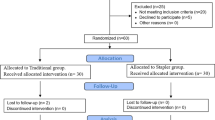Abstract
This study aimed to evaluate the value of using a linear stapler device in total laryngectomy using a prospective study. Twenty-one total laryngectomies were performed from August 2010 to April 2012, using TA-60 linear stapler for pharyngeal closure. Data collected included age, sex, staging, surgical margins and postoperative course (including complications and swallowing). Patients comprised twenty men and one woman. The mean age was 64 years. Two patients underwent preoperative radiotherapy. Four patients recurred after radiotherapy. Fifteen patients were untreated. Negative surgical margins were achieved in all patients. One patient developed slight pharyngocutaneous fistula. Patients resumed oral intake at 7 days. The mean hospital stay was 10 days. Using a linear stapler to close laryngopharyngeal cavity in total laryngectomy is simple, reliable and practical, avoids pollution of surgical area, saves operation time and decreases the incidence of pharyngocutaneous fistula. It is worthy of clinical application for selected cases. Level of Evidence Case-series





Similar content being viewed by others
References
Bedrin L, Ginsburg G, Horowitz Z, Talmi YP (2005) 25-year experience of using a linear stapler in laryngectomy. Head Neck 27(12):1073–1079
Lukyanchenko AG (1971) Suturing of laryngeal defect in laryngectomy. Vestn Otorinolaringol 33:29–30
Paches AI, Ogol’tsova ES, Petrova NP et al (1972) Vestn Akad Med Nauk SSSR 27(5):43–46
Paches AI Ogol’tsova ES, Tsybyrne GA et al (experimental study) (1972) Zh Ushn Nos Gorl Bolezn 32:61–66
Halevy A, Sade J (1983) The use of thoracoabdominal staplers in ENT surgery. Arch Otorhinolaryngol 237:185–190
Westmore GA, Knowles JE (1983) The use of a stapling instrument for postlaryngectomy pharyngeal repair. J Laryngol Otol 97:775–778
Agrawal A, Schuller DE (2000) Closed laryngectomy using the automatic linear stapling device. Laryngoscope 110:1402–1405
Altissimi G, Frenguelli A (2007) Linear stapler closure of the pharynx during total laryngectomy: a 15-year experience (from closed technique to semi-closed technique Acta Otorhinolaryngol Ital 27(3):118–122
Bresson K, Rasmussen H, Rasmussen PA (1974) Pharyngocutaneous fistula in totally laryngectomised patients. J Laryngol Otol 88:835–842
Lundgren J, Olafsson J (1979) Pharyngocutaneous fistula following total laryngectomy. Clin Otolaryngol 4:13–23
Davis RK, Vincent ME, Shapshay SM, Strong MS (1982) The anatomy and complications of “T” versus vertical closure of the hypopharynx after laryngectomy. Laryngoscope 92:16–22
Weingrad DN, Spiro RH (1983) Complication after laryngectomy. Am J Surg 146:517–520
Stell PM, Cooney TC (1974) Management of the fistula of the head and neck after radical surgery. J Laryngol Otol 88:819–834
Dedo DD, Alonso WA, Ogura JH (1975) Incidence, predisposing factors and outcome of pharyngocutaneous fistula complicating head and neck cancer surgery. Ann Otol Rhinol Laryngol 84:833–840
Calli C, Pinar E, Oncel S (2011) Pharyngocutaneous fistula after total laryngectomy: less common with mechanical stapler closure. Ann Otol Rhinol Laryngol 120(5):339–344
Acknowledgments
The authors are grateful to Scientific and Technique Program of Guangdong Province (2011B031800221).
Conflict of Interest
None.
Author information
Authors and Affiliations
Corresponding author
Additional information
X. Zhang and Z. Liu made the same contribution to this work.
Rights and permissions
About this article
Cite this article
Zhang, X., Liu, Z., Li, Q. et al. Using a linear stapler for pharyngeal closure in total laryngectomy. Eur Arch Otorhinolaryngol 270, 1467–1471 (2013). https://doi.org/10.1007/s00405-012-2180-7
Received:
Accepted:
Published:
Issue Date:
DOI: https://doi.org/10.1007/s00405-012-2180-7




